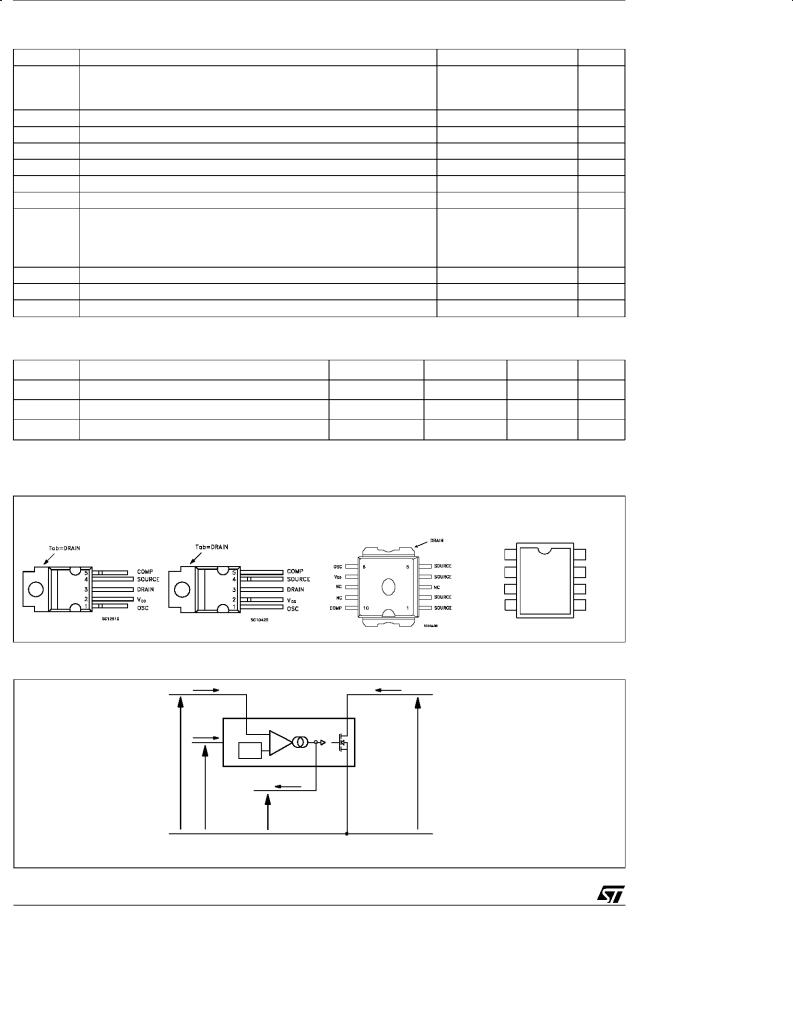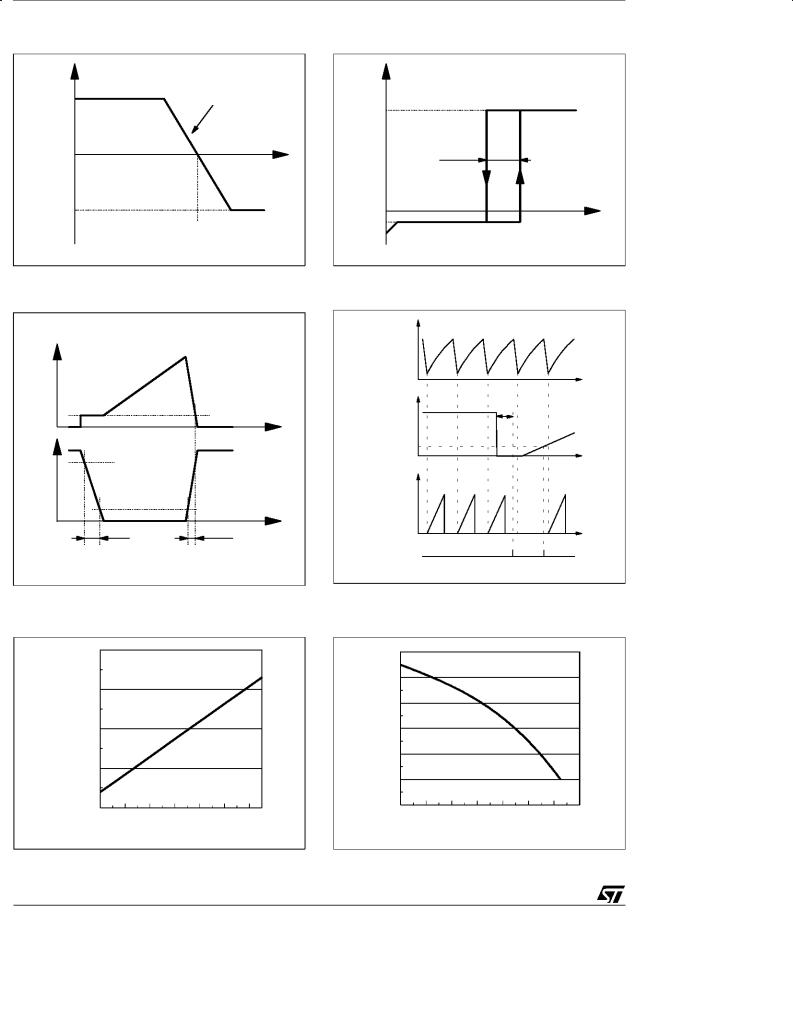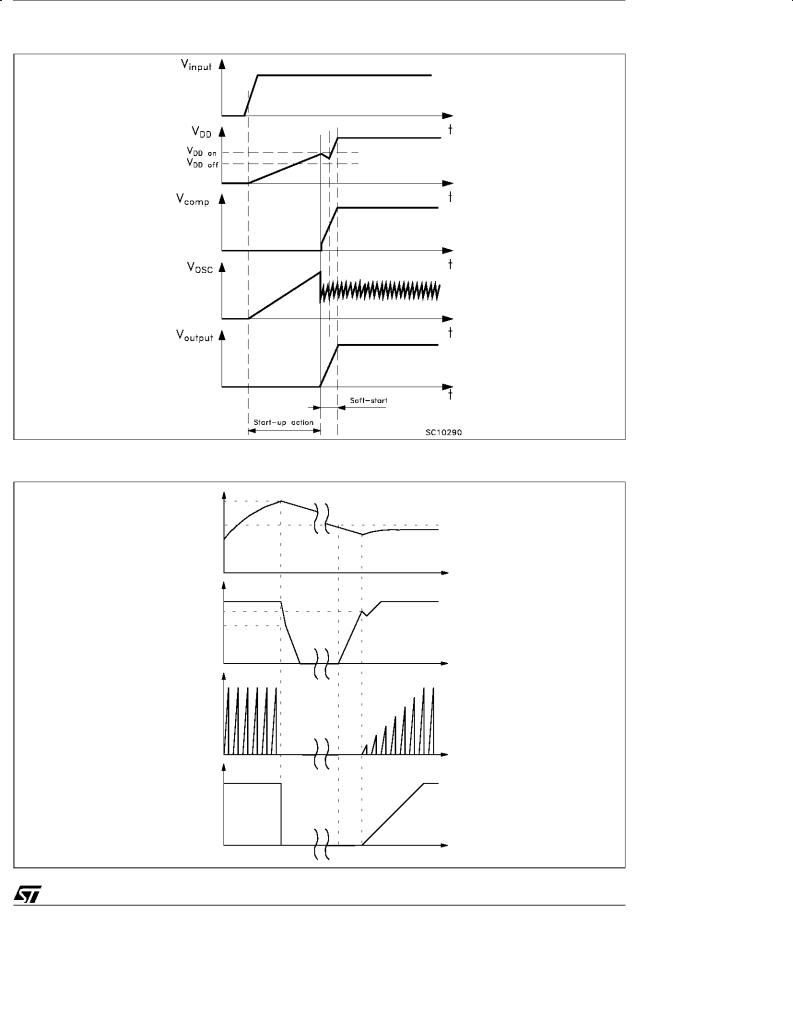SGS Thomson Microelectronics VIPER20SP, VIPER20DIP, VIPER20ASP, VIPER20ADIP, VIPER20A Datasheet
...
T YPE |
VDSS |
In |
RDS(on) |
VIPer20/SP/DIP |
620V |
0.5 A |
16 Ω |
VIPer20A/ASP/ADIP |
700V |
0.5 A |
18 Ω |
VIPer20/SP/DIP
VIPer20A/ASP/ADIP
SMPS PRIMARY I.C.
FEATURE
■ADJUSTABLE SWITCHING FREQUENCY UP TO 200KHZ
■CURRENT MODE CONTROL
■SOFT START AND SHUT DOWN CONTROL
■AUTOMATIC BURST MODE OPERATION IN STAND-BY CONDITION ABLE TO MEET ºBLUE ANGELº NORM (<1W TOTAL POWER CONSUMPTION)
■INTERNALLY TRIMMED ZENER REFERENCE
■UNDERVOLTAGE LOCK-OUT WITH HYSTERESIS
■INTEGRATED START-UP SUPPLY
■AVALANCHE RUGGED
■OVERTEMPERATURE PROTECTION
■LOW STAND-BY CURRENT
■ADJUSTABLE CURRENT LIMITATION
DESCRIPTION
VIPer20/20A, made using VIPower M0
BLOCK DIAGRAM
|
ON/OFF |
|
|
|
SECURITY |
|
|
LATCH |
VDD |
UVLO |
R/S FF Q |
LOGIC |
||
|
|
S |
|
|
OVERTEMP. |
|
|
DETECTOR |
|
0.5 V + |
1.7 |
|
_ |
μs |
|
delay |
|
|
|
|
|
ERROR |
|
|
AMPLIFIER |
|
|
_ |
|
|
13 V + |
|
|
4.5V |
|
PENTAWATT HV |
PENTAWATT HV (022Y) |
|
|
10 |
|
1 |
|
PowerSO-10 |
DIP-8 |
Technology, combines on the same silicon chip a state-of-the-art PWM circuit together with an optimized high voltage avalanche rugged Vertical Power MOSFET (620V or 700V / 0.5A).
Typical applications cover off line power supplies with a secondary power capability of 10W in wide range condition and 20W in single range or with doubler configuration. It is compatible from both primary or secondary regulation loop despite using around 50% less components when compared with a discrete solution. Burst mode operation is an additional feature of this device, offering the possibility to operate in stand-by mode without extra components.
OSC |
|
|
|
DRAIN |
|
|
OSCILLATOR |
|
|
|
|
|
|
PWM |
|
|
|
|
|
|
LATCH |
|
|
|
|
|
|
|
S |
|
|
|
|
|
R1 FF Q |
|
|
|
|
|
|
R2 |
R3 |
|
|
|
|
|
|
|
|
0.5V |
|
|
|
|
|
+ |
+ |
_ |
6 V/A |
|
|
250 ns |
|
|
|||
|
|
|
|
|||
|
|
|
|
|
|
|
|
Blanking |
_ |
|
|
|
|
|
|
|
|
|
CURRENT |
|
|
|
|
|
|
AMPLIFIER |
|
COMP |
|
|
|
SOURCE |
FC00491 |
|
|
|
|
|
|||
November 1999 |
1/21 |

VIPer20/SP/DIP - VIPer20A/ASP/ADIP
ABSOLUTE MAXIMUM RATING
Symb ol |
Parameter |
Value |
Uni t |
VDS |
Continuous Drain-Source Voltage (Tj = 25 to 125oC) |
|
|
|
for VIPer20/SP/ DIP |
-0.3 to 620 |
V |
|
for VIPer20A/ ASP/ADIP |
-0.3 to 700 |
V |
ID |
Maximum Current |
Internally Limited |
A |
VDD |
Supply Voltage |
0 to 15 |
V |
VOSC |
Voltage Range Input |
0 to VDD |
V |
VCOMP |
Voltage Range Input |
0 to 5 |
V |
ICOMP |
Maximum Continuous Current |
±2 |
mA |
Vesd |
Electrostatic discharge (R = 1.5 KΩ C = 100pF) |
4000 |
V |
ID(AR) |
Avalanche Drain-Source Current, Repetitive or Not-Repetitive |
|
|
|
(TC = 100 oC, Pulse Width Limited by TJ max, δ <1%) |
0.5 |
A |
|
for VIPer20/SP |
||
|
for VIPer20A/ ASP/ADIP |
0.4 |
A |
Ptot |
Power Dissipation at Tc = 25oC |
57 |
W |
Tj |
Junction Operating Temperature |
Internally Limited |
oC |
Ts tg |
Storage Temperature |
-65 to 150 |
oC |
THERMAL DATA
|
|
|
|
PENT AW ATT PowerSO-10 |
DIP-8 |
|
|
Rthj-p in |
|
|
|
|
|
20 |
oC/W |
Rt hj-ca se |
Thermal |
Resistance Junction-case |
Max |
2.0 |
2.0 |
|
oC/W |
Rth j-a mb. |
Thermal |
Resistance Ambient-case |
Max |
70 |
60 |
35 # |
oC/W |
(*) When mounted using the minimum recommended pad size on FR-4 board. |
|
|
|
||||
# On multylayer PCB |
|
|
|
|
|
|
|
CONNECTION DIAGRAMS (Top View) |
|
|
|
|
|
PENTAWATT HV PENTAWATT HV (022Y) |
PowerSO-10 |
DIP-8 |
|
|
|
|
|
OS C |
1 |
8 |
DRAIN |
|
|
Vdd |
|
|
DRAIN |
|
|
SOURC E |
|
|
DRAIN |
|
|
COMP |
4 |
5 |
DRAIN |
|
|
|
|
SC 10540 |
|
CURRENT AND VOLTAGE CONVENTIONS |
|
|
|
|
|
IDD |
|
ID |
|
|
|
VDD |
DRAIN |
|
|
|
|
IOSC |
- |
|
|
|
|
OSC |
+ |
|
|
|
|
13V |
|
|
|
|
|
VDD |
COMP SOURCE |
|
|
|
|
VDS
ICOMP
VOSC
VCOMP
FC00020
2/21

VIPer20/SP/DIP - VIPer20A/ASP/ADIP
ORDERING NUMBERS
PENTAW AT T HV |
PENT AW ATT HV (022Y) |
PowerSO-10 |
DIP -8 |
VIPer20 |
VIPer20 (022Y) |
VIPer20SP |
VIPer20DIP |
VIPer20A |
VIPer20A (022Y) |
VIPer20ASP |
VIPer20ADIP |
PINS FUNCTIONAL DESCRIPTION
DRAIN PIN:
Integrated power MOSFET drain pin. It provides internal bias current during start-up via an integrated high voltage current source which is switched off during normal operation. The device is able to handle an unclamped current during its normal operation, assuring self protection against voltage surges, PCB stray inductance, and allowing a snubberless operation for low output power.
SOURCE PIN:
Power MOSFET source pin. Primary side circuit common ground connection.
VDD PIN :
This pin provides two functions :
-It corresponds to the low voltage supply of the control part of the circuit. If VDD goes below 8V, the start-up current source is activated and the output power MOSFET is switched off until the VDD voltage reaches 11V. During this phase, the internal current consumption is reduced, the VDD pin is sourcing a current of about 2mA and the COMP pin is shorted to ground. After that, the current source is shut down, and the device tries to start up by switching again.
-This pin is also connected to the error amplifier, in order to allow primary as well as secondary regulation configurations. In case of primary regulation, an internal 13V trimmed reference voltage is used to maintain VDD at 13V. For secondary regulation, a voltage between 8.5V and 12.5V will be put on VDD pin by transformer design, in order to stuck the output of the transconductance amplifier to the high state. The COMP pin behaves as a
constant current source, and can easily be connected to the output of an optocoupler. Note that any overvoltage due to regulation loop failure is still detected by the error amplifier through the VDD voltage, which cannot overpass 13V. The output voltage will be somewhat higher than the nominal one, but still under control.
COMP PIN :
This pin provides two functions :
-It is the output of the error transconductance amplifier, and allows for the connection of a compensation network to provide the desired transfer function of the regulation loop. Its bandwidth can be easily adjusted to the needed value with usual components value. As stated above, secondary regulation configurations are also implemented through the COMP pin.
-When the COMP voltage is going below 0.5V, the shut-down of the circuit occurs, with a zero duty cycle for the power MOSFET. This feature can be used to switch off the converter, and is automatically activated by the regulation loop (whatever is the configuration) to provide a burst mode operation in case of negligible output power or open load condition.
OSC PIN :
An RT-CT network must be connected on that pin to define the switching frequency. Note that despite the connection of RT to VDD, no significant frequency change occurs for VDD varying from 8V to 15V. It provides also a synchronisation capability, when connected to an external frequency source.
3/21

VIPer20/SP/DIP - VIPer20A/ASP/ADIP
AVALANCHE CHARACTERISTICS
Symb ol |
Parameter |
Max |
Valu e |
Uni t |
ID(a r) |
Avalanche Current, Repetitive or Not-Repetitive |
|
|
|
|
(pulse width limited by Tj max, δ < 1%) |
|
0.5 |
A |
|
for VIPer20/SP/ DIP |
|
||
|
for VIPer20A/ ASPA/ DIP |
(see fig.12) |
0.4 |
A |
E(ar) |
Single Pulse Avalanche Energy |
|
10 |
mJ |
|
(starting Tj = 25 oC, ID = ID(ar)) |
(see fig.12) |
|
|
ELECTRICAL CHARACTERISTICS (TJ = 25 oC, |
VDD = 13 V, unless otherwise specified) |
|
|||||
POWER SECTION |
|
|
|
|
|
|
|
Symb ol |
Parameter |
T est Con ditio ns |
Mi n. |
Typ . |
Max. |
Un it |
|
BVDSS |
Drain-Source Voltage |
ID = 1 mA |
VCOMP = 0 V |
|
|
|
|
|
|
for VIPer20/SP/DIP |
620 |
|
|
V |
|
|
|
for VIPer20A/ASP/DI P (see fig.5) |
700 |
|
|
V |
|
IDSS |
Off-State Drain Current |
VCOMP = 0 V |
TJ= 125 oC |
|
|
|
|
|
|
VDS = 620 V |
|
|
|
1.0 |
mA |
|
|
for VIPer20/SP/DIP |
|
|
|
|
|
|
|
VDS = 700 V |
|
|
|
1.0 |
mA |
|
|
for VIPer20A/ASP/ADIP |
|
|
|
|
|
RDS( on) |
Static Drain Source on |
ID = 0.4 A |
|
|
|
|
Ω |
|
Resistance |
for VIPer20/SP/DIP |
|
13.5 |
16 |
||
|
|
for VIPer20A/ASP/ADIP |
|
15.5 |
18 |
Ω |
|
|
|
ID = 0.4 A |
TJ = 100 oC |
|
|
|
Ω |
|
|
for VIPer20/SP/DIP |
|
|
29 |
||
|
|
for VIPer20A/ASP/ADIP |
|
|
32 |
Ω |
|
tf |
Fall Time |
ID = 0.2 A |
Vin = 300 V (1) |
|
100 |
|
ns |
|
|
(see fig.3) |
|
|
|
|
|
tr |
Rise Time |
ID = 0.4 A |
Vin = 300 V (1) |
|
50 |
|
ns |
|
|
(see fig. 3) |
|
|
|
|
|
COSS |
Output Capacitance |
VDS = 25 V |
|
|
90 |
|
pF |
(1) On Inductive Load, Clamped. |
|
|
|
|
|
|
|
SUPPLY SECTION |
|
|
|
|
|
|
|
Symb ol |
Parameter |
T est Con ditio ns |
Mi n. |
Typ . |
Max. |
Un it |
|
IDDch |
Start-up Charging |
VDD = 5 V |
VDS = 70 V |
|
-2 |
|
mA |
|
Current |
(see fig. 2 and fig. 15) |
|
|
|
|
|
IDD0 |
Operating Supply Current |
VDD = 12 V, |
FSW = 0 KHz |
|
12 |
16 |
mA |
|
|
(see fig. 2) |
|
|
|
|
|
IDD1 |
Operating Supply Current |
VDD = 12 V, |
FSW = 100 KHz |
|
13 |
|
mA |
IDD2 |
Operating Supply Current |
VDD = 12 V, |
FSW = 200 KHz |
|
14 |
|
mA |
VDDo ff |
Undervoltage Shutdown |
(see fig. 2) |
|
7.5 |
8 |
|
V |
VDDo n |
Undervoltage Reset |
(see fig. 2) |
|
|
11 |
12 |
V |
VDDhyst |
Hysteresis Start-up |
(see fig. 2) |
|
2.4 |
3 |
|
V |
4/21

VIPer20/SP/DIP - VIPer20A/ASP/ADIP
ELECTRICAL CHARACTERISTICS (continued)
OSCILLATOR SECTION
Symb ol |
Parameter |
T est Con ditio ns |
|
FSW |
Oscillator Frequency |
RT = 8.2 KΩ |
CT =2.4 nF |
|
Total Variation |
VDD = 9 to15 V |
|
|
|
with RT ± 1% |
CT ± 5% |
(see fig. 6 and fig. 9)
Mi n. Typ . Max. Un it
90 100 110 KHz
VOSCih |
Oscillator Peak Voltage |
7.1 |
V |
VOSCi l |
Oscillator Valley Voltage |
3.7 |
V |
ERROR AMPLIFIER SECTION
Symb ol |
Parameter |
Test Cond ition s |
Mi n. Typ . Max. Un it |
|||||
VDDreg |
VDD Regulation Point |
ICOMP = 0 mA |
(see fig.1) |
12.6 |
13 |
13.4 |
V |
|
VDDreg |
Total Variation |
TJ = 0 to 100 oC |
|
|
2 |
|
% |
|
GBW |
Unity Gain Bandwidth |
From Input = VDD to Output = VCOMP |
|
150 |
|
KHz |
||
|
|
COMP pin is open |
(see fig. 10) |
|
|
|
|
|
AVOL |
Open Loop Voltage |
COMP pin is open |
(see fig. 10) |
45 |
52 |
|
dB |
|
|
Gain |
|
|
|
|
|
|
|
Gm |
DC Transconductance |
VCOMP = 2.5 V |
(see fig. 1) |
1.1 |
1.5 |
1.9 |
mA/V |
|
VCOMPL O |
Output Low Level |
ICOMP = -400 μA |
VDD = 14 V |
|
0.2 |
|
V |
|
VCOMPHI |
Output High Level |
ICOMP = 400 μA |
|
VDD = 12 V |
|
4.5 |
|
V |
ICOMPLO |
Output Low Current |
VCOMP = 2.5 V |
|
VDD = 14 V |
|
-600 |
|
μA |
|
Capability |
|
|
|
|
|
|
|
ICOMPHI |
Output High Current |
VCOMP = 2.5 V |
|
VDD = 12 V |
|
600 |
|
μA |
|
Capability |
|
|
|
|
|
|
|
PWM COMPARATOR SECTION
Symb ol |
Parameter |
HID |
VCOMP / IDpea k |
VCOMPof f VCOMP offset |
|
IDpeak |
Peak Current Limitation |
td |
Current Sense Delay |
|
to turn-off |
tb |
Blanking Time |
ton( mi n) |
Minimum on Time |
Test Cond ition s |
Mi n. Typ . Max. |
Un it |
||
VCOMP = 1 to 3 V |
4.2 |
6 |
7.8 |
V/A |
IDp eak = 10 mA |
|
0.5 |
|
V |
VDD = 12 V COMP pin open |
0.5 |
0.67 |
0.9 |
A |
ID = 1 A |
|
250 |
|
ns |
|
|
250 |
360 |
ns |
|
|
350 |
|
ns |
SHUTDOWN AND OVERTEMPERATURE SECTION
Symb ol |
Parameter |
Test Cond ition s |
Mi n. |
Typ . |
Max. |
Un it |
VCOMPth |
Restart threshold |
(see fig. 4) |
|
0.5 |
|
V |
tDI Ssu |
Disable Set Up Time |
(see fig. 4) |
|
1.7 |
5 |
μs |
Tt sd |
Thermal Shutdown |
(see fig. 8) |
140 |
170 |
190 |
oC |
|
Temperature |
|
|
|
|
|
Thyst |
Thermal Shutdown |
(see fig. 8) |
|
40 |
|
oC |
|
Hysteresis |
|
|
|
|
|
5/21

VIPer20/SP/DIP - VIPer20A/ASP/ADIP
Figure 1: VDD Regulation Point
COMP |
|
I |
Slope = |
|
|
ICOMPHI |
Gm in mA/V |
VDD
0
ICOMPLO
VDDreg
FC00150
Figure 3: Transition Time
ID
10% Ipeak
t
VDS
90% VD
10% VD
t
tf |
tr |
FC00160
Figure 5: Breakdown Voltage vs Temperature
FC0 0 180
1.15
BVDS S
(Nor malize d)
1. 1
1.05
1
0.95
0 |
20 |
40 |
60 |
80 |
100 |
120 |
Temp era ture ( C)
Figure 2: Undervoltage Lockout
IDD
IDD0
VDDhyst |
VDS = 70 V |
|
Fsw = 0 |
||
|
||
VDDoff |
VDD |
|
VDDon |
||
IDDch |
|
|
|
FC00170 |
Figure 4: Shut Down Action
VOS C |
|
|
t |
VCOMP |
tDIS s u |
|
|
VCOMPth |
t |
ID |
|
|
t |
ENABLE |
ENABLE |
|
DISABLE |
|
FC 00 0 6 0 |
Figure 6: Typical Frequency Variation
FC0 019 0
1
(%)
0
-1
-2
-3
-4
-5
0 |
20 |
40 |
60 |
80 |
100 |
120 |
140 |
Temperature ( C)
6/21

VIPer20/SP/DIP - VIPer20A/ASP/ADIP
Figure 7: Start-up Waveforms
Figure 8: Overtemperature Protection
Tj
Tt sd
Tt s d-Thys t
t
Vdd
Vddo n
Vddoff
t
Id
t
Vco mp
t
SC1 019 1
7/21
